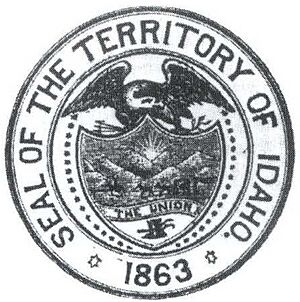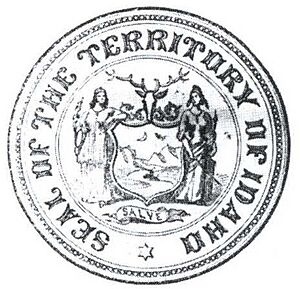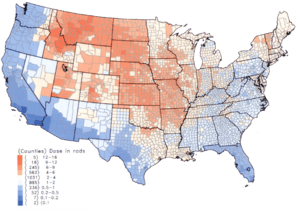History of Idaho facts for kids
The history of Idaho explores the story of people and activities in the state of Idaho, which is part of the United States. Idaho is located in the Pacific Northwest, a region near the west coast of the U.S. and Canada. This area also includes parts of southern Alaska, all of British Columbia, Washington, Oregon, western Montana, northern California, and Nevada.
Contents
European Explorers Arrive
|
Cataldo Mission
|
|

HABS, view from northwest, in 1957.
|
|
| Lua error in Module:Location_map at line 420: attempt to index field 'wikibase' (a nil value). | |
| Location | Cataldo, Idaho |
|---|---|
| Built | 1848 |
| Architect | Antonio Ravalli |
| Architectural style | Greek Revival, Colonial, Other |
| NRHP reference No. | 66000312 |
Quick facts for kids Significant dates |
|
| Added to NRHP | October 15, 1966 |
| Designated NHL | July 4, 1961 |
Idaho was one of the last places in the lower 48 U.S. states to be explored by people from Europe. The famous Lewis and Clark team entered Idaho on August 12, 1805, at Lemhi Pass. Another early group, led by Wilson Price Hunt in 1811 and 1812, explored southern Idaho by traveling along the Snake River. At that time, about 8,000 Native Americans lived in the region.
Fur Trading and Early Posts
The fur trade brought the first large groups of Europeans to Idaho. Andrew Henry built Fort Henry in 1810 near modern St. Anthony, Idaho. This was the first American fur trading post west of the Rocky Mountains, but it was soon abandoned.
The British-owned Hudson's Bay Company later took control of the fur trade in the Snake River area by the 1820s. Donald Mackenzie of the North West Company also played a big role. He explored the Salmon and Clearwater Rivers and was one of the first to reach Fort Astoria in Oregon in 1812. Mackenzie led fur trading trips up the Snake River, and Fort Nez Percés became an important base. He even tried to find a way to travel by boat up the Snake River, but found it too difficult.
American fur traders like William H. Ashley and Jedediah Smith also expanded their business into Idaho in 1824. A big meeting of trappers, called a rendezvous, happened at Pierre's Hole in 1832. This was followed by a battle between the Gros Ventre tribe and American trappers, who were helped by their Nez Perce and Flathead allies.
Missionaries and Settlements
People also came to Idaho to do missionary work with Native Americans. In 1809, Kullyspell House, Idaho's first trading post, was built. In 1836, Reverend Henry H. Spalding started a Protestant mission near Lapwai. He printed the first book in the Northwest, opened Idaho's first school, created its first irrigation system, and grew the state's first potatoes. Narcissa Whitman and Eliza Hart Spalding were the first non-Native women to enter what is now Idaho.
The Cataldo Mission, Idaho's oldest standing building, was built by the Coeur d'Alene tribe and Catholic missionaries. In 1842, Father Pierre-Jean De Smet chose a spot for the mission along the St. Joe River. The mission was moved in 1846 to avoid floods. In 1850, Antonio Ravalli designed a new building, and Native Americans built it without using nails, using a method called wattle and daub. The Cataldo Mission became a key stop for traders, settlers, and miners, offering rest and supplies.
Changing Territories
At this time, the Idaho region was part of an area called Oregon Country, which both the United States and Great Britain claimed. The U.S. gained full control in 1846 with the Oregon Treaty. In 1848, Oregon Territory was created, covering what is now Oregon, Washington, and Idaho. In 1853, the northern part of Idaho became part of Washington Territory. The future state of Idaho was reunited in 1859 when Oregon became a state and Washington Territory's borders changed.
Thousands of people traveled through Idaho on the Oregon Trail or during the California gold rush of 1849, but few stayed. In 1860, the first of several gold rushes in Idaho began at Pierce. By 1862, mining booms led to new settlements in both northern and southern Idaho.
Early Settlers in Idaho
Mormon Pioneers
Mormon pioneers founded Fort Lemhi in 1855, but it didn't last. The first organized town in Idaho was Franklin, settled in April 1860 by Mormons who thought they were in Utah Territory. A later survey showed they had actually crossed into Idaho. Mormon settlers went on to create many communities in Southeastern Idaho.
English Immigrants
Many English immigrants moved to Idaho in the late 1800s and early 1900s. They found they had more property rights and paid less taxes than in England. Many came from humble backgrounds and became important figures in Idaho, like Frank R. Gooding, who became the state's seventh governor. Today, people of English descent make up a large part of Idaho's population.
German Immigrants
Many German farmers also settled in Idaho during this time. Most German settlers were Lutheran, but some were Catholic. In parts of Northern Idaho, German was the main language until World War I, when German-Americans were encouraged to speak only English. Today, Idahoans of German ancestry are the second largest ethnic group in the state.
Irish Immigrants
A significant number of people from Ireland came to North America after the Potato Famine. Some moved west to find land for agriculture. Many settled in Montana and southern Idaho. The Catholic Church already had a presence in the state, so many Irish Catholics also settled in Boise. Today, about 10% of Idahoans say they have Irish ancestry.
African Americans in Idaho
York, who helped Lewis and Clark, was the first recorded African American in Idaho. After slavery was abolished, many African Americans moved west. Some settled near Pocatello and worked as ranchers, entertainers, and farmers. Even though they were free, many faced discrimination in the early to mid-120th century. The African American population in Idaho continues to grow, with people coming for education, military service, and jobs. There is a Black History Museum in Boise that tells the story of early African Americans in the state.
Basque Immigrants
Basque people from Spain and southern France traditionally worked as shepherds. They came to Idaho, bringing their strong work ethic and looking for new opportunities. Boise has one of the largest Basque communities in the U.S., and the city holds an annual festival celebrating their culture.
Chinese Immigrants
In the mid-1800s, Chinese immigrants came to America through San Francisco to work on the railroads and start businesses. They faced discrimination from groups like the Anti-Chinese League, which tried to limit their rights. Today, Asians are the third largest demographic group in Idaho after White and Hispanic people.
Idaho Becomes a Territory
On March 4, 1863, President Abraham Lincoln signed a law creating Idaho Territory. It was formed from parts of Washington Territory and Dakota Territory, with its capital in Lewiston. The original Idaho Territory included most of what later became Idaho, Montana, and Wyoming. It had fewer than 17,000 people. Idaho Territory took on its current state borders in 1868 and became a state in 1890.
Idaho Becomes a State
When President Benjamin Harrison signed the law making Idaho a U.S. state on July 3, 1890, the population was 88,548. George L. Shoup became the state's first governor, but he resigned after a few weeks to become a U.S. Senator.
Miners' Conflicts
In its early years as a state, Idaho experienced labor problems in the mining areas of Coeur d'Alene. In 1892, miners went on strike, which led to a violent conflict between union miners and company guards. The Frisco mine was blown up, and guards were taken prisoner. The fighting spread, and the Idaho National Guard and federal troops were sent in. Union miners were held in temporary prisons.
More trouble erupted at the Bunker Hill facility in 1899 when union miners were fired. Angry union members blew up the Bunker Hill Mill, killing two company workers. In both conflicts, the miners were fighting for better pay, shorter hours, the right to join a union, and against the use of spies by mine owners. The violence from the union was met with a harsh response from authorities.
These mining battles were connected to a larger miners' strike in Colorado. The conflict reached a peak in December 1905 with the killing of former Governor Frank Steunenberg by Harry Orchard, a union member. Orchard was supposedly angry about Steunenberg's actions against the 1899 miner uprising.
A detective named James McParland investigated the killing. In 1907, "Big Bill" Haywood and two other leaders of the Western Federation of Miners (WFM) were tried for planning Steunenberg's murder. Orchard testified against them. The trial was famous, with Senator William Edgar Borah as the prosecutor and Clarence Darrow defending the union leaders. The defense showed that Orchard might have been a paid informant for the mine owners. Two WFM leaders were found not guilty, and the third was released. Orchard was convicted and spent the rest of his life in an Idaho prison.
Mining in Idaho's History
Mining was a very important business in Idaho, bringing a lot of attention to the state. From 1860 to 1866, Idaho produced a significant amount of all the gold in the United States.
Most of Idaho's mining production from 1860 to 1969 came from metals. The Coeur d'Alene region produced the most, accounting for about 80% of Idaho's total mining output.
Key Mining Areas
Other important mining areas included Boise Basin, Wood River Valley, Stibnite, Blackbirg, and Owyhee. Many other areas like Atlanta, Bear Valley, Bay Horse, Florence, Gilmore, Mackay, Patterson, and Yankee Fork also produced a lot of minerals. Smaller mining operations were found in places like Goose Creek, near Cleveland, Fort Hall, and Montpelier.
Progressive Changes
Idaho was one of the states that readily adopted progressive ideas in the late 1800s and early 1900s. The state supported policies like women's suffrage (giving women the right to vote) in 1896 and prohibition (banning alcohol) in 1916, even before these became federal laws. Idahoans also strongly supported Free Silver, a policy about money.
After becoming a state, Idaho's economy slowly changed from mainly mining to mainly agriculture, especially in the south. Older mining towns like Silver City became less important, while farming communities like Nampa and Twin Falls grew. The Milner Dam on the Snake River, finished in 1905, helped create many farming communities in the Magic Valley region, which had been mostly empty before.
Some mining towns, like those in Blaine County, changed into resort areas. The Sun Valley ski resort opened there in 1936. Other old mining towns, like Silver City, became ghost towns.
Idaho from the 1950s to Today
In northern Idaho, mining remained important for several more decades. However, the closure of the Bunker Hill Mine in Shoshone County in the early 1980s hurt the region's economy. Since then, a big increase in tourism in northern Idaho has helped the area recover. Coeur d'Alene, a town by a lake, is a popular place for visitors.
In the 1980s, some groups with extreme views appeared in North Idaho, including the Aryan Nations. These groups were mostly found near Coeur d'Alene. In 1992, a tense standoff happened between U.S. Marshals, the F.B.I., and a family at Ruby Ridge in northern Idaho. Tragic events occurred, including deaths, which caused a lot of discussion about how much force the government should use in such situations.
In 2001, the Aryan Nations property in Hayden Lake, Idaho, was taken away after a court case, and the group moved out of state. Around the same time, Boise built an impressive Human Rights Memorial with a statue of Anne Frank and quotes about freedom and equality. Recent surveys show that Idaho citizens generally accept people from different cultures and backgrounds.
The state's population has become more diverse, especially in Boise. This growth in different groups has led to economic expansion and a high standard of living.
Nuclear Fallout in Idaho
Idaho was one of several states that received a lot of nuclear fallout from atomic tests at the Nevada Test Site in the 1950s and 1960s. Government reports show that many Idaho citizens suffered health problems and even died because of these tests.
See also
 In Spanish: Historia de Idaho para niños
In Spanish: Historia de Idaho para niños





